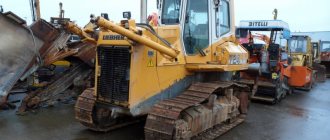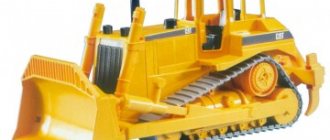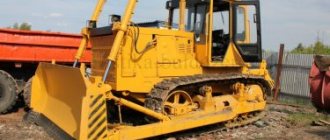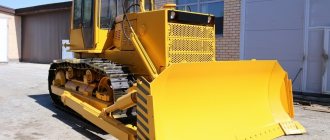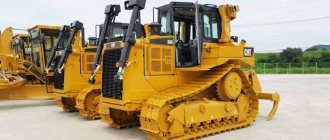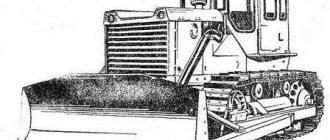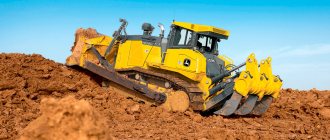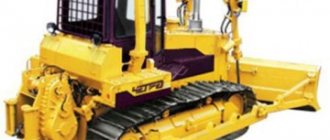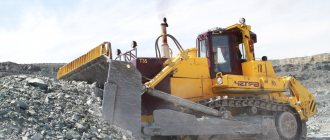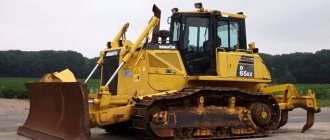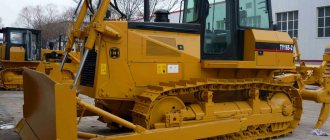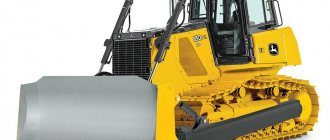Among all the technical characteristics of the bulldozer, the traction class of the base tractor used occupies a special place. From the point of view of current technical standards, the traction class represents the maximum traction force that a tractor can provide when performing work using attachments over an extended period of time. The speed developed in this case is from 2.5 to 3 km/h, and slipping does not exceed 20%.
The traction class of the base machine acts as the main criterion for the following classification of bulldozers:
- small-sized models of special equipment with a class not exceeding 0.9;
- light bulldozers with a class from 1.4 to 4;
- medium models of bulldozers (class from 6 to 15);
- heavy bulldozers, the class of which has parameters from 25 to 35;
- super-heavy models of special equipment (class above 35).
From a “mechanical shovel” to a high-tech unit
By the way, the word “bulldozer”, which appeared in everyday use at the same time, did not characterize any specific mechanism, but the force that had to be applied in order to move any mass. The first progenitor of this unit, referred to only as a “mechanical shovel,” looked very impressive, was clumsy, noisy and had only 15-30 hp. With. power. But still, in the middle of the 19th century it was a certain success. And after just a short period of time, the power units of these machines acquired the necessary power to carry out the entire range of work.
Go to the bulldozer catalog
A modern, familiar bulldozer is a complex engineering machine or a separate attachment that operates in a cyclic manner. The main working unit of a bulldozer is the blade. A separate drive of the working part (hydraulic or mechanical) is capable of raising, turning, tilting and lowering the blade. Thanks to this, the cost of such high-power equipment when moving soil is minimized. After all, engine power is not wasted on this. A modern bulldozer is a self-propelled machine, most often built on a tractor chassis (tracked or wheeled) and equipped with a blade of various designs. However, both a self-propelled excavator and a pipe layer can have a bulldozer blade, which greatly increases their performance and versatility.
Construction of bulldozers
The most common bulldozers are those with a fixed blade, those with a rotating blade, bulldozers-rippers, and bulldozers-loaders.
Rice. 1. Crawler bulldozers with fixed blades:
a) - with rigid push bars, b) - with hinged bars;
1 - blade, 2 - supporting frame, 3 - hydraulic cylinder for raising and lowering the blade, 4 - sleeve, 5 - subframe, 6 - cross beam, 7 - push bar, 8 - tractor, 9 - knife, 10 - engine, 11 - clutch clutches, 12 — cabin, 13 — gearbox, 14 — rear axle, 15 — sprocket, 16 — crawler, 17 — track, 18 — hinge, 19 — hydraulic brace, 20 — universal joint;
Blade position: I – lower, II – working, III – transport/
Bulldozers with fixed blades
Bulldozers with fixed blades come with rigid (Fig. 1, a) and articulated (Fig. 1, b) push bars.
Bulldozers with fixed blades and rigid push bars
The bulldozer of the first type is equipped with a blade 1, to which two push bars 7 are rigidly welded, enclosing the base tractor 8 from the outside. The bars are hinged on a transverse beam 6, bolted to the tractor frame. A subframe 5 is also attached to it at the front, to which one double-acting hydraulic cylinder 3 is hinged through the supporting frame 2. Two high-pressure hoses 4 are connected to the hydraulic cylinder, which connect it to the tractor hydraulic system. It consists of a hydraulic pump, hydraulic distributor, hydraulic tank and hydraulic lines. By applying the oil pressure developed by the hydraulic pump to one cavity of the hydraulic cylinder, the bulldozer blade is raised, and lowered into the other. The blade in the soil cutting zone is equipped with removable knives 9.
Bulldozers are distributed according to traction force:
- for small-sized ones, with a tractive effort of up to 0.6 tons. Used in gardening to move small volumes of loose materials.
- light, with a capacity of 0.6 to 3 tons. The main tractor for city utilities. Used for clearing snow, removing debris, moving light construction materials (dry sand, small crushed stone, etc.). An example is: tractors produced by MTZ (Belarus), YuMZ-6KM.
- medium, from 3 to 9 tons. Used for developing soils of category 1-2. Cleaning and planning of the territory. An example is the DT-75, T-4, T-8 tracked tractors.
- heavy, from 9 to 35 tons. They represent the main fleet of bulldozer equipment. They are used in the construction of roads, the construction of embankments, dams, the development of open-pit natural resources, the preparation of construction sites, backfilling and planning of large production sites in terms of volume and area. Allows aggregation with a ripper for the development of frozen and rocky soils of categories 3-5. Previous classes of machines do not allow the installation of a ripper. An example is the bulldozer T 170, bulldozer B10, bulldozer B12, DET 250.
- super heavy, more than 35 tons. Used for the development of rocks and rocks. Construction of especially large facilities such as the Sayano-Shushenskaya hydroelectric power station. Example: T 35, T 800.
Traction force is the force that the bulldozer develops on the hook, which is usually located at the rear. In accordance with Newton's 3rd law, the mass of the tractor is always greater than the traction force.
Bulldozer classification
Bulldozers are classified:
- by appointment;
- type of chassis;
- designs of working equipment;
- form and purpose of the working body;
- type of drive of working equipment;
- traction class of the base vehicle (engine power).
Bulldozers by purpose
Bulldozers are classified according to their purpose:
- general purpose;
- special.
General purpose bulldozers
General purpose bulldozers are used to perform the main types of earthmoving, transport and auxiliary work on various soils and in climatic conditions of the temperate zone with an ambient temperature of ± 40 ° C, cold climates with air temperatures up to - 60 ° C, as well as in tropical conditions with temperatures up to 50 °C.
Special bulldozers
Special bulldozers are designed to perform targeted work in specific soil or technological conditions. They produce track-laying bulldozers used in laying roads and tracks, pusher bulldozers - for working with scrapers, bilge bulldozers - for stacking materials and minerals in the holds of ships, underground bulldozers - for working in mines and adits, underwater bulldozers - for working in water.
Bulldozers by chassis type
Bulldozers are produced according to the type of chassis:
- tracked;
- wheeled.
Crawler bulldozer
The crawler bulldozer is the most widely used, as it can be used in difficult ground conditions.
Wheel bulldozer
A wheeled bulldozer is used when working in lighter road conditions and when there is a need to frequently move from site to site.
Bulldozers by design of working equipment
According to the design of the working equipment, bulldozers are distinguished:
- with a fixed blade;
- rotary blade in plan;
- universal;
- bulldozers-loaders.
Bulldozers with fixed blade
In bulldozers with a fixed blade, it is installed perpendicular to the longitudinal axis of the machine, motionless or with a slight angular swing in the transverse plane.
Rotary Blade Bulldozers
In bulldozers with a rotating blade, it can be rotated at a certain angle in both directions from the main position.
Universal bulldozers
Universal bulldozers are equipped with an articulated blade made of two identical parts, which can be installed perpendicular to the longitudinal axis of the machine, at an angle in one direction or at an angle in different directions.
Bulldozers-loaders
Bulldozer-loaders are characterized by the fact that the blade is hinged on the lifting boom; instead, you can hang a cargo bucket or other types of replaceable working equipment (for example, a hook).
Bulldozers according to the shape of the working body
According to the shape of the working body, they are distinguished:
- straight;
- hemispherical;
- spherical dumps.
A straight blade has the same shape across its entire width. The ends of the hemispherical blade are bent forward to the width of the side knives. In a spherical blade, the side sections are moved forward by V3 of width.
Purpose of bulldozer blades
According to their purpose, dumps are divided into:
- earth mover;
- rocky;
- snow;
- carbonic;
- dumps for pushing scrapers;
- removal of wood waste and garbage.
The excavation blade is used in the development of soils and bulk materials.
A rock dump with a thicker front sheet and reinforced metal structure is designed for moving rocks and large lump materials.
A snow blade, consisting of two halves installed at a certain angle to one another, is used for snow removal.
A coal dump is used for storing materials.
The blade for pushing scrapers is reinforced in the middle part with a thick sheet.
Dumpboards for collecting wood waste and debris are made in large sizes and are equipped with a slotted visor.
Bulldozers drive type of working equipment
By type of drive of working equipment, bulldozers with hydraulic and rope-block control are known.
Bulldozers by engine power
According to the class, which means the nominal traction force of the base tractor, the following types of bulldozers are distinguished:
- small-sized
(class up to 0.9, power 18.5...37 kW), - light
(classes 1.4...4, power 37...96 kW), - medium
(classes 6…15, power 103…154 kW), - heavy
(classes 25...35, power 220...405 kW), - super-heavy
(classes 50...100, power 510...880 kW).
Purpose of bulldozer equipment
This classification is based on the design features and shape of the blade. It is worth noting that the blade is a kind of shovel or bucket made of high-strength steel.
Go to the bulldozer catalog
In construction and earthmoving work, spherical, straight and hemispherical types of dumps have found their use, which can additionally be equipped with special overhanging canopies. In addition, each of these types has different tilt and rotation angles. Komatsu equipment has proven itself well in this field. By the way, this is the first company that has supplemented the bulldozers they produce with an on-board computer and a navigation system. Uprooting bulldozers and brush cutters can be distinguished as a separate type. These are mainly light and medium types of cars, but there are also heavy ones, and less often – super-heavy ones. They are intended mainly for work in forest belts. Particularly successful types of this equipment are produced by Caterpillar (CAT), which is a world leader in the production of construction and special mechanisms, systems and units. By the way, a bulldozer is used not only in construction, land reclamation, forestry and agriculture, leveling landfills, but also in rescue work. This machine is equipped with a special type of blade, the sides of which fold. Still, rescue equipment is designed to work in difficult conditions; accordingly, it is necessary to ensure a high level of safety for the operator servicing it. The cabins of such bulldozers have a complex air purification system, or can be completely sealed.
Criteria for effectively selecting a bulldozer
Before purchasing or renting a bulldozer, be sure to evaluate the specifics of the work and relate them to the following operational characteristics:
- specificity and scope of the task;
- towing class and power of a specific model;
- the company that produced the selected model (KOMATSU, Leafsree, XGMA, CAT, etc.).
Choosing a model of special equipment of the highest quality (from a well-known manufacturer) and profitable savings will not be effective if the traction class of the bulldozer is not comparable to the volume of work expected to be performed or its specificity. Heavy work with soil requires the use of a bulldozer with a high traction class . Using such a machine in conditions of high precision work will entail significant fuel consumption, which is extremely pointless and economically ineffective.
Return to articles
Rippers
We discussed above what a bulldozer is. Among the working equipment of this machine, it is also worth noting the rippers. The main element of this unit is the tooth, which consists of a landing shank, tip, protective cover and fasteners.
Modern devices use racks (as load-bearing parts of bulldozer equipment). They can be of three types: curved, straight or partially curved. Most often, curved models are found, since they experience less tension during the loosening process. At the same time, the elements are susceptible to jamming when processing medium and large blocks on frozen and dense soil. Straight or slightly curved analogues are more practical in this regard.
Equipment
During any work shift, the bulldozer is equipped with special loosening equipment, the power of which can reach 368 kW. The working body is designed to destroy dense and frozen soil - it separates it from the general massif in the form of blocks, followed by leveling. The unit is installed on the rear of the tractor base, the front base of which is equipped with the main bulldozer attachment.
A machine with a fixed blade cannot change the position of the working tool to the right or left. Analogs with a rotating unit rotate it in plan by up to 35 degrees on each side.
